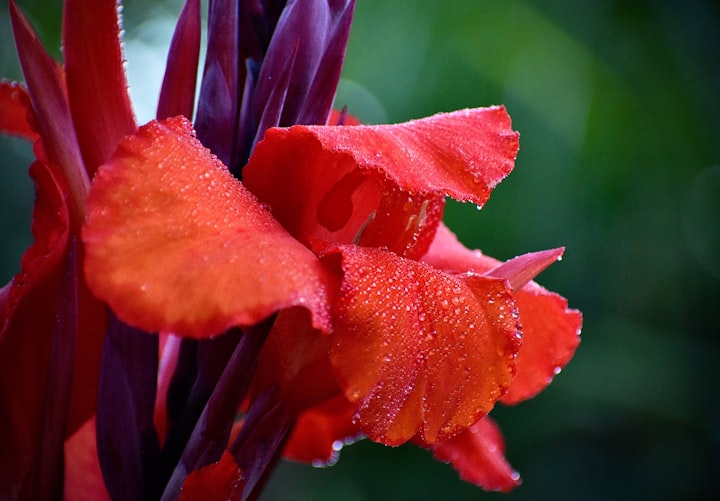Canna Lily Care 101: A Comprehensive Guide for Beginners
Cannaceae

Canna Lily is a fantastic addition to any garden or landscape with its stunning flowers and lush foliage. The Canna Lily, also known simply as Canna or Canna Lily, is a genus of flowering plants in the family Cannaceae. They are native to the Americas' tropical and subtropical regions but also cultivated in many other parts of the world as ornamental plants.
Canna Lilies are known for their large, vibrant flowers and lush foliage. Flowers can come in various colors, including red, orange, yellow, and pink. The foliage is usually green, but there are also cultivars with bronze or variegated leaves.
Canna Lilies often add a tropical touch to gardens and landscapes. They are also famous for creating colorful borders or as focal points in flower beds. In colder climates, the rhizomes can be lifted and stored indoors during winter and replanted in the spring.
It's worth noting that while the Canna Lily is a beautiful plant, all parts of it are considered toxic if ingested, so caution should be exercised if you have children, pets, or livestock around these plants.
Choosing the Right Location
Consider Climate and Hardiness: Canna Lilies are native to tropical and subtropical regions and thrive in warm climates. However, they can also be grown in cooler regions if you choose hardy cultivars or take measures to protect them during winter. Check your area's hardiness zone and select Canna Lily varieties suitable for your climate.
Sunlight Requirements: Canna Lilies are sun-loving plants that require ample sunlight to flourish. Ideally, they should be planted in a location that receives full sun, which means at least 6 to 8 hours of direct sunlight daily. However, they can tolerate partial shade, especially in hot climates, where some protection from intense afternoon sun can be beneficial.
Wind Protection: Canna Lilies have large, broad leaves susceptible to wind damage. Strong winds can cause the leaves to tear or break, which can affect the overall health and appearance of the plant. Consider planting them in a location that provides some natural wind protection, such as near a fence, wall, or other sturdy plants that can act as a windbreak.
Also Read: Growing and Maintaining Hydrangea Plants
Soil Drainage: Well-draining soil is crucial for the health of Canna Lilies. They prefer soil that allows excess water to drain freely, preventing soggy conditions leading to root rot. Avoid planting them in areas with heavy clay soil or poorly drained soil. If your soil is rich, you can improve drainage by amending it with organic matter like compost or sand.
Aesthetics and Garden Design: Consider the overall aesthetics and garden design when choosing the location for your Canna Lilies. These plants can create a focal point with vibrant flowers and lush foliage. Plant them where their beauty can be appreciated, such as along borders, near patios or entrances, or in beds with complementary plants that enhance their visual appeal.
Planting Canna Lily
- Timing: Canna Lilies are typically planted in spring after the last frost date in your area. Soil temperatures should consistently exceed 50°F (10°C) for successful growth. Planting at the right time ensures the rhizomes have sufficient warmth and favorable conditions to establish and grow.
- Rhizome Preparation: Before planting, it's essential to prepare the Canna Lily rhizomes properly: a. Inspect the rhizomes for any signs of damage, disease, or rot. Discard any that appear unhealthy. b. If the rhizomes are large or crowded with multiple eyes (buds), you can divide them by carefully cutting them apart with a clean, sharp knife. Each divided section should have at least one healthy eye. c. To prevent rot or fungal diseases, you can soak the rhizomes in a fungicide solution for about 15 minutes. Allow them to air dry before planting.
- Planting Depth: When planting Canna Lilies, it's essential to consider the appropriate depth for the rhizomes: a. Dig a hole about 4 to 6 inches (10 to 15 cm) deep. b. Place the rhizome horizontally in the hole with the eye bud facing up. The eye bud is a small, rounded protrusion on the rhizome. c. Cover the rhizome with soil, gently pressing it down to eliminate air pockets. d. Ensure that the top of the rhizome is about 2 inches (5 cm) below the soil surface.
- Spacing: Proper spacing allows adequate air circulation and prevents overcrowding. Space your Canna Lily rhizomes at least 1 to 2 feet (30 to 60 cm) apart. This spacing also ensures that each plant has enough space to grow and develop a robust root system. After planting, thoroughly water your Canna Lilies to settle the soil and provide moisture for the roots.
Canna Lily Care
Watering
Canna Lilies prefer consistently moist soil throughout the growing season. Water deeply whenever the top inch of soil feels dry, aiming to keep the soil evenly moist but not soggy. During hot, dry periods, they may require more frequent watering. Be sure to water at the base of the plant, avoiding overhead watering, which can lead to fungal diseases.
Also Read: Are Hydrangeas Poisonous to Cats?
Fertilizing
To promote healthy growth and abundant blooms, fertilize your Canna Lilies regularly. Start by incorporating a balanced, slow-release fertilizer into the soil at planting time. Then, during the growing season, feed them every 4 to 6 weeks with a balanced granular or liquid fertilizer. Follow the manufacturer's instructions for application rates and methods. Avoid over-fertilization, which can lead to excessive foliage growth with fewer flowers.
Mulching
Applying a layer of organic mulch around the base of the plants helps retain soil moisture, suppresses weed growth, and regulates soil temperature. Use a 2- to 3-inch (5- to 7.5-cm) layer of mulch, such as straw, wood chips, or compost, ensuring that it doesn't directly touch the rhizomes. Mulching also adds a decorative touch to the garden bed. However, be cautious not to pile the mulch directly against the stems or rhizomes, as it can create excess moisture and encourage rot.
Pruning and Deadheading
Regular pruning and deadheading help maintain the health and appearance of your Canna Lilies. Remove any yellow, damaged, or withered leaves by cutting them back to the base of the plant. This helps prevent the spread of diseases and pests. Deadhead spent flowers cutting the stalk just above the nearest healthy bud or leaf. Removing faded blooms encourages the plant to redirect its energy toward new growth and more flower production.
Pest and Disease Control
While Canna Lilies are generally resilient, they occasionally face pest and disease issues. Common pests include slugs, snails, aphids, and caterpillars. Regularly inspect your plants for any signs of infestation, and take appropriate measures such as handpicking or using organic pest control methods. Proper air circulation and avoiding overhead watering can help prevent fungal diseases such as leaf spots or rust. If necessary, treat fungal diseases with appropriate fungicides following the product instructions.
Staking
Tall varieties of Canna Lilies may benefit from staking for support. As the plants grow, insert stakes near the rhizomes and gently tie the stalks to the stakes using soft ties or twine. This helps prevent the plants from bending or falling over in strong winds or heavy rainfall.
Winter Care (In Cold Climates)
Canna Lilies are not frost-tolerant if you live in an area with cold winters. Before the first frost, cut back the foliage to a few inches above the ground. Carefully dig up the rhizomes, brush off excess soil, and allow them to air dry for a day or two. Store the rhizomes in a cool, dry location for winter. Place them in containers with peat moss, vermiculite, or dry sand to prevent them from drying out. Check on the rhizomes periodically to ensure they remain healthy during storage.
Division and Transplanting
Canna Lily clumps can become crowded over time, decreasing blooming and vitality. Dividing the rhizomes every few years helps rejuvenate the plants. Wait until spring when new growth emerges, and carefully lift the clumps from the ground. Separate the rhizomes by cutting them apart, ensuring each division has at least one healthy eye. Replant the divisions in prepared soil or share them with fellow gardeners.
Conclusion
Embarking on the journey of growing and caring for Canna Lily flowers is like entering a world of tropical enchantment right in your backyard. These vibrant plants can transform any garden into a beautiful oasis with majestic blooms and lush foliage.
So, embrace this botanical adventure, and let the allure of Canna Lilies inspire your green thumb and ignite your passion for gardening. May the vibrant colors, the tender care, and the joy of witnessing their growth fill your heart with a sense of wonder and fulfillment.
👉 Do you have any additional insights or questions? We highly value your feedback. Please share your thoughts by leaving a comment below.
About the Creator
Amir Hossain
I blog on everything and anything— hoping my blogs will make your days a bit happier!






Comments
There are no comments for this story
Be the first to respond and start the conversation.